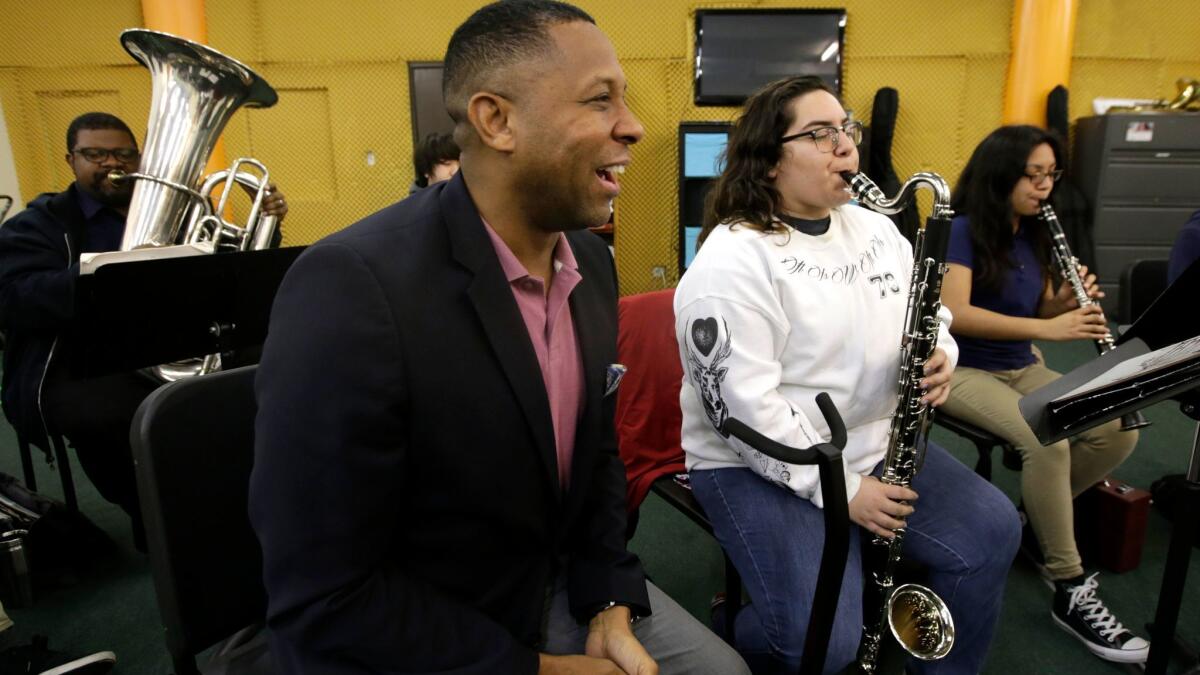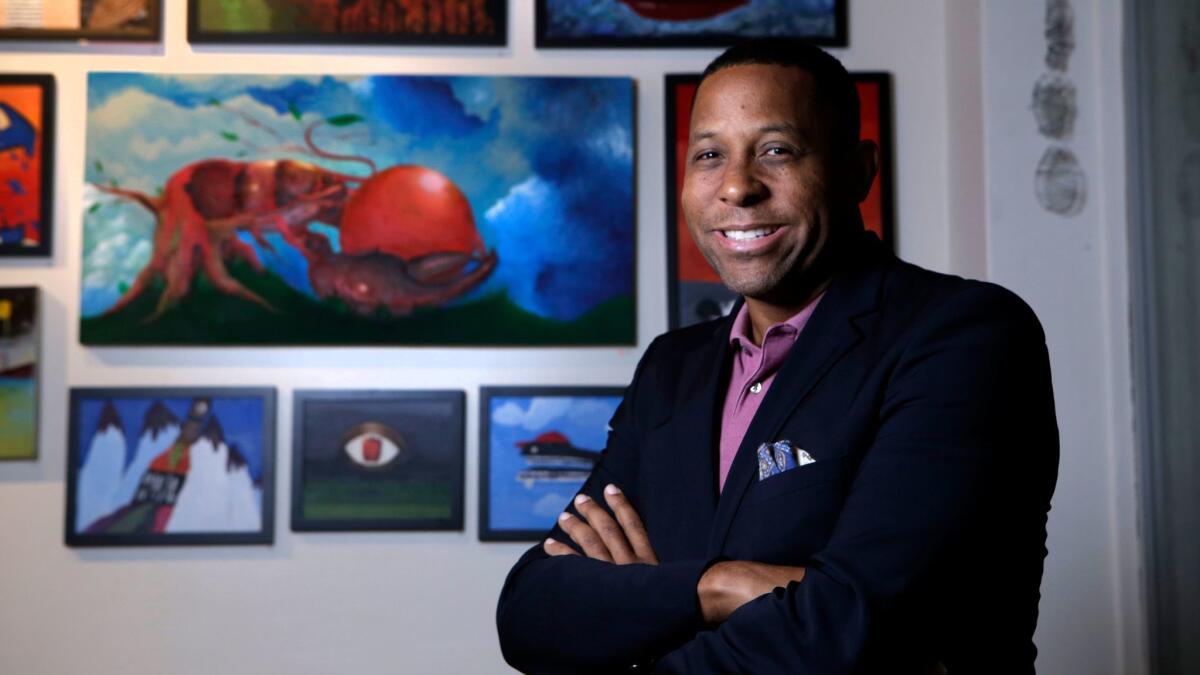He believes in the arts as a basic right for kids. He is getting a $200,000 award for working for that

- Share via
Few would expect the cacophony coming from the third floor of this plain white building off Wilshire Boulevard. In one room this evening, high school students on flutes and clarinets blaze through their warm-up of scales and arpeggios before launching into a John Williams piece. Across the hallway, middle-school string players run through part of Stravinsky’s “The Firebird.”
For these students, the majority of whom live in poverty, an arts education is a luxury — one possible only through Heart of Los Angeles, or HOLA, a nonprofit for youth in the Rampart community.
On Thursday, the driving force behind HOLA, executive director Tony Brown, will be one of six Californians to receive a $200,000 leadership award from the James Irvine Foundation. The money, Brown says, will go a long way toward providing kids with what they so often lack: opportunity.
Brown walks into one rehearsal space and a big smile spreads across his face. He waves at the students, taking a seat in the woodwinds section to chitchat with the young musicians.
In another room, Brown fist bumps a cello player and high-fives another before talking with a parent waiting outside.
“Every student considers him like a celebrity,” says Sandie Villanueva, who works in development for HOLA and is an alumna of the program. “That’s what makes him unique.”
Across the street, an art teacher leads middle school students in an activity connecting sculpture with nature. On the walls hang student paintings and drawings from HOLA’s surrealism gallery. The building is one of four dedicated to programs in the arts, sciences, other academic subjects and athletics.

Brown, 46, has been the visionary behind the nonprofit’s growth, from serving five kids to more than 2,300 each year. He says the James Irvine Foundation award will help HOLA to provide enrichment programs to even more kids. “There’s another path to help develop our young people and develop a brighter future for them,” he says. “And it has a lot of the things that we put in their lives that have been stripped out of their schools.”
But HOLA had more modest beginnings.
Founded by Mitchel Moore in 1989 in a worn-down church gym, HOLA served as a safe haven for Rampart youth trapped in poverty and gang violence.
Brown was one of HOLA’s first employees.
The youngest of four boys, Brown grew up in Sierra Madre near Pasadena. As part of the only black family in his neighborhood, Brown says singing in the Pasadena Boys Choir, swimming competitively and participating in other sports helped to give him a place within the community.
“Sports was the way I think we felt connected to the kids in our classroom and our neighbors,” Brown said. Music was another way. “Those were the places where we were safe to have conversations. Those were the places where you felt very equal to.”
After working for HOLA in the early 1990s, he left to teach PE at a private school in Brentwood. Brown then moved to Tennessee, and after earning a master’s degree, he returned to L.A. for a corporate job.
While working for Fox Sports Net, Brown had a brother who died. “He was feeling like he wasn’t doing anything that was really redemptive and helping the community,” HOLA founder Moore says. “We had lunch and I invited him to come back.”
In 2003, Brown returned to HOLA as its director of development. He became executive director in 2007.
While he was rising through the ranks, Brown brought another one of his brothers, an artist who would later die from his drug addiction, to HOLA. “He went for his tour and saw all the artwork on the wall,” Brown said. “I remember him stopping and just saying, ‘I wish I would have had this when I was a kid.’”
It was a turning point. In his brother, Brown saw the lost opportunity to support young people. So he dedicated himself to HOLA and to growing its programming.
They’re not getting healthy adult-to-youth interactions. They’re not feeling connected to the very city that they’re growing up in.
— Tony Brown
Brown helped the organization to secure partnerships. The Los Angeles Philharmonic offers intensive orchestra lessons to HOLA students. The Lakers partly sponsored HOLA’s athletic center.
“I realized that [the kids] needed help beyond their school day. They needed expanded learning opportunities. They needed a place to express themselves,” Brown said. “I just started peeling back the layers. They’re not getting healthy adult-to-youth interactions. They’re not feeling connected to the very city that they’re growing up in.”
Moore said it was hard for him to let go of HOLA because he started it from nothing and nurtured it for 18 years. “But I was feeling burnt out, and Tony Brown was the only person I knew that I could turn it over to with confidence,” said Moore, who retired. “He had the same passion and actually had more gifts than I had. I felt that he was more qualified than me in the end.”
Brown has two biological children, but he also refers to HOLA’s students as “my kids.” He can talk all day about them: The clarinetist who played in London with the L.A. Phil’s youth orchestra, another musician who was a herald trumpet in the Rose Parade, the student caught up in gang violence who went on to become a published author.
“I feel a responsibility to keep them safe and when they hurt, like my kids, I want to find out what’s the matter,” he said.
The hodgepodge of student paintings, drawings and old photographs that fills the walls in Brown’s office provides another glimpse into that life. On the floor sit several posters. They are the plans for a new and expanded arts building, which will double the number of children HOLA can serve.
Brown is excited about the future, but he also recalls his early HOLA days, when the organization was small enough that he could take high school kids out to eat and see their pure joy being around an adult who cared.
“My interaction isn’t what it used to be. I miss the days where I could go every single day, as a routine, and go visit kids in the programming that we offer,” Brown said. “Now I’m lucky this year to get there more than once a week through programs. I miss that. I look forward to a return.”
ALSO
Al Pacino and the role that pulled him to the Pasadena Playhouse stage
Jane Kaczmarek, ‘Long Day’s Journey’ and her complete departure from ‘Malcolm’
‘Zoot Suit’: How Latino theater born in the farm fields changed L.A. theater forever
Demian Bichir plays it cool in ‘Zoot Suit’
‘Waitress’ and ‘The Color Purple’ coming to the Hollywood Pantages
Diego Rivera’s Cubist masterpiece arrives at LACMA
More to Read
The biggest entertainment stories
Get our big stories about Hollywood, film, television, music, arts, culture and more right in your inbox as soon as they publish.
You may occasionally receive promotional content from the Los Angeles Times.











